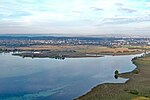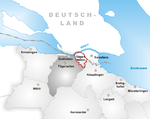Wollmatinger Ried
Geography of Lake ConstanceIUCN Category IVKonstanz (district)Natura 2000 in GermanyNature reserves in Baden-Württemberg ... and 1 more
Ramsar sites in Germany

The nature reserve of Wollmatinger Ried – Untersee – Gnadensee is a protected area on the shores of Lake Constance in Germany. It has an area of 767 hectares and is the largest and most important nature reserve on the German side of Lake Constance. It is rich in plant and animal species and extends from the banks of the Seerhein river west of Constance via the causeway to the Island of Reichenau in the Untersee to the eastern Gnadensee near Allensbach-Hegne. The nearby offshore islands of Triboldingerbohl (Langenrain) and Mittler or Langbohl (Kopf) are part of the reserve.
Excerpt from the Wikipedia article Wollmatinger Ried (License: CC BY-SA 3.0, Authors, Images).Wollmatinger Ried
Technische-Betriebe Nord, Verwaltungsgemeinschaft Konstanz
Geographical coordinates (GPS) Address External links Nearby Places Show on map
Geographical coordinates (GPS)
| Latitude | Longitude |
|---|---|
| N 47.676388888889 ° | E 9.1277777777778 ° |
Address
Wollmatinger Ried - Untersee - Gnadensee
Technische-Betriebe Nord
78467 Verwaltungsgemeinschaft Konstanz, Konstanz-Industriegebiet
Baden-Württemberg, Germany
Open on Google Maps









